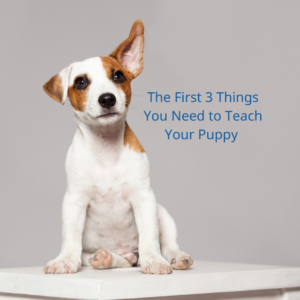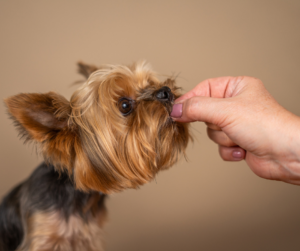Michael Baugh CDBC CPDT-KSA
Balanced trainers pride themselves on using a mix of positive reinforcement dog training and, when needed, punishment. They might use food and praise or even clicker training. They might also use choke collars, prong collars, or even shock collars. At first glance it sounds pretty good. Let’s use all the tools and techniques available to us. And if the dog does well with positive reinforcement we don’t have to resort to the nasty stuff. Fair enough. Right?
Honestly, I can see the appeal. But I see the trap doors and trip wires, too.
The truth is all dogs do well with positive reinforcement training. We know this because it’s the natural way all organisms learn. No one invented this. We discovered it. It’s a law of nature like gravity. You don’t have to believe in gravity. It just is. You don’t have to believe in positive reinforcement either. It simply is and it doesn’t fail (just like nothing ever falls up). Balanced trainers rest on some binary thinking that seems intuitive. If the dog fails, then we resort to pain or intimidation (the euphamism they often use is “pressure.”) But, here’s the flaw in their logic. Our dogs don’t fail. Nature has already hard-wired them to learn this way. So, where’s the failure? Why do we so easily reach for the leash correction or the shock collar?
 Here’s what I’ve learned. Positive reinforcement is easy for our dogs. It’s hard for us. Don’t misunderstand. The ideas are straightforward and clear. And even the mechanics of doing positive reinforcement dog training are fairly easy. Some of us just have a hard time wrapping our brains around it. We humans are bombarded with punishment and the threat of punishment all day everyday. I can understand how we could see punishment-based dog training as a viable option (or perhaps the only option). Even dog trainers dedicated to teaching with positive reinforcement struggle. We learn and re-learn year-after-year. We need reminding because positive reinforcement doesn’t come naturally to some of us. We know it works. Yes. We can see it working, of course. And yet, we remain blind. A balanced trainer is simply this: a positive reinforcement trainer who lost sight.
Here’s what I’ve learned. Positive reinforcement is easy for our dogs. It’s hard for us. Don’t misunderstand. The ideas are straightforward and clear. And even the mechanics of doing positive reinforcement dog training are fairly easy. Some of us just have a hard time wrapping our brains around it. We humans are bombarded with punishment and the threat of punishment all day everyday. I can understand how we could see punishment-based dog training as a viable option (or perhaps the only option). Even dog trainers dedicated to teaching with positive reinforcement struggle. We learn and re-learn year-after-year. We need reminding because positive reinforcement doesn’t come naturally to some of us. We know it works. Yes. We can see it working, of course. And yet, we remain blind. A balanced trainer is simply this: a positive reinforcement trainer who lost sight.
Positive reinforcement training teaches our dogs what to do. It’s proactive. Come. Sit. Lie down. Stay. Punishment is reactive. And here’s how else balanced dog training fails. Punishment doesn’t really teach our dog what we think it does. It doesn’t teach him what not-to-do. When the scale tumbles toward using pain and intimidation in training we are tumbling with it into some treacherous territory. Here’s what we’ve learned over the past century about what punishment really teaches.
Escape. We and our dogs retreat from things that are painful or scary. This is as natural as positive reinforcement, but it’s much less precise. A dog escaping a shock by running back to his human can masquerade as good training. But, we are teaching the dog more about what he’s running from than what he’s running to. Don’t count on any lasting dog-human bonding here. There’s also the very real danger of the punishment getting hitched up with other triggers in the environment. Think of ripples in a pond. The shock is scary. Run. But what else is associated with the shock? A bird? A cracking twig? That guy over there? Lot’s of things can start to spook our dog now. Anything can predict a shock and lead to a terrified bolting dog. Plus, we are sliding dangerously close to Escape’s more troubling cousin.
Avoidance. Sometimes we just shut down. We’re done. I’ve met dogs trained on shock collar fence systems who won’t leave their back porch. I’ve met dogs for whom walks are so punishing they are afraid to go out at all. I’ve met dogs who hide and cower and won’t do anything. Of course, this common effect of punishment doesn’t look like training at all. The dogs get slapped with labels like “stubborn” or even “dominant” when in fact they are just terrified of what could be. It’s sad but not as dangerous as what could come next.
Counter Coercion. That’s the technical term for pushing back. We do it. Some dogs do it. There are plenty of studies now that link painful training with owner-directed aggression. I suspect that the ripple effect of punishment is what leads to dogs lashing out at less culpable targets as well. Violence begets violence. It’s a mnemonic we know well but too often forget when we think of our dogs. And too many dogs end up paying for our forgetfulness with their lives.
I sometimes wonder what life would be like if we constantly supported and encouraged each other’s best behavior choices. And then in the next thought, what if we could start doing that even just a little. What if, instead of crashing into a punishing day, we tilted into the nature of our better angels. What if we could tip the scale all the way to a lighter, more joyful, more natural kind of being – with our dogs and with each other? What if our lives, in this one beautiful way, were delightfully out of balance?
Michael Baugh teaches dog training in Houston TX. He specializes in fearful and aggressive dog training.
 #3 Come When I Call. This one takes priority for me because it’s so easy. Our little puppies are already following us around, curious about our every movement. Let’s use that to our advantage. Call them often and give a small bit of food every time they come. To make it even more effective, choose a word or phrase (also called a cue) that you will use every time, and every time they come you be sure to give that little morsel of food. Your dog will grow up having learned that coming when called is always good news. They’ll run to you every time you call.
#3 Come When I Call. This one takes priority for me because it’s so easy. Our little puppies are already following us around, curious about our every movement. Let’s use that to our advantage. Call them often and give a small bit of food every time they come. To make it even more effective, choose a word or phrase (also called a cue) that you will use every time, and every time they come you be sure to give that little morsel of food. Your dog will grow up having learned that coming when called is always good news. They’ll run to you every time you call.

